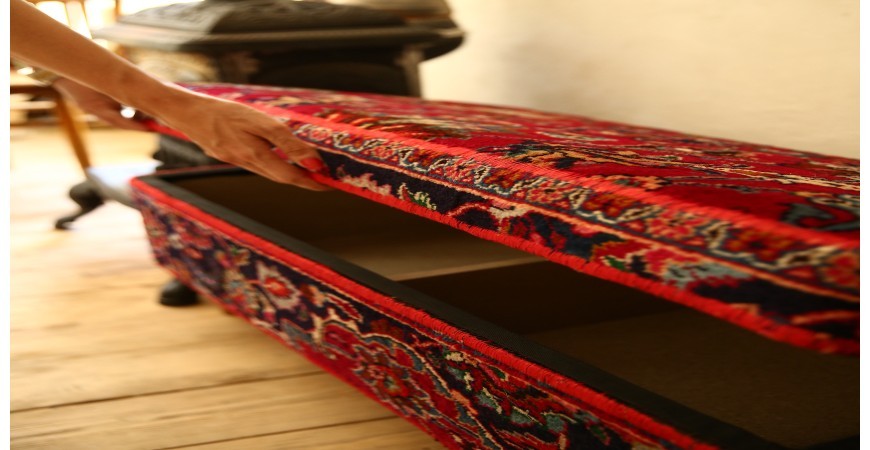
Handwoven Carpets: A Sustainable Art and Everlasting Legacy
Our behavior toward nature throughout history, especially in the past century, has not only been unfriendly but downright hostile. The reality is that we set out to destroy nature, using all our resources to achieve this goal—and we were successful. Now that nature has turned its back on us, we are slowly realizing how unkind we’ve been to it and, ultimately, to ourselves. Though it may seem too late, we must act. At the very least, we should not stand idly by and do nothing during a time when nature is upset with us.

Today, each of us, in any position or capacity we hold, has a responsibility toward nature and future generations. One effective way to contribute to sustainability and environmental recovery is the concept of reusing products—those items that, after reaching the end of their useful life, would otherwise be discarded. This process of discarding is where the harm to both ourselves and nature is most evident.

In recent decades, the world has increasingly gravitated toward reusing and recycling products. Initiatives such as waste separation at the source represent humanity’s early steps in facilitating this practice. Similarly, the use of organic, chemical-free agricultural products is another measure adopted in recent decades to preserve the health of humans and the environment.
Handwoven Carpets: Merging Sustainability and Cultural Heritage
A hallmark of Persian heritage, handwoven carpets are both an irreplaceable cultural artifact and a prime example of a sustainable, environmentally-friendly product. Unlike industrial production, which often generates massive waste and environmental harm, Persian carpets are a remarkable exception. From their inception to the end of their lifecycle, these treasures optimize natural resource consumption with virtually no waste. Even as they age or wear out over centuries, Persian carpets find new life: as decorations, crafts, artistic recyclables, and creative uses. One striking example is the repurposing of old carpet pieces into accessories called “carpet accessories.”
.jpg)
Sustainability Features of Handwoven Persian Carpets
Sustainability in handwoven carpets encompasses aspects like natural raw materials, traditional manufacturing methods, and preservation of cultural aesthetics. These features not only minimize environmental harm but also strengthen local economies and regional cultural heritage.

Factors of Sustainability in Handwoven Carpets:
Natural Raw Materials:
Handwoven carpets are typically made using wool, silk, cotton, and vegetable-based dyes. Unlike machine-made carpets that utilize synthetic fibers and industrial dyes, handwoven carpets have minimal negative environmental impact.
Traditional Production Methods:
Handmade carpets are crafted using traditional techniques by local artisans. These approaches, unlike industrial carpet manufacturing, rely on manual labor and maintain traditional weaving methods, contributing to the preservation of indigenous crafts.
Waste Reduction & Recycling:
Handwoven carpets are recyclable. Their scraps and leftover pieces can be repurposed into other products, such as poufs, cushions, mats, and even wall art. This practice cuts down waste and fosters sustainable consumption cycles.
Support for Local Producers:
Purchasing handwoven carpets not only supports local art and culture but also boosts the economy in traditional regions of production. Artisans, often based in rural and underprivileged areas, directly benefit from this industry.
Durability & Longevity:
Due to high-quality materials and meticulous craftsmanship, handwoven carpets exhibit exceptional resilience and extended lifespans, contributing to their value as a sustainable product.
Positive Environmental and Economic Impacts of Handwoven Carpets
Eco-Friendliness:
Utilizing natural materials and traditional methods reduces ecological harm, promoting environmental health.
Economic Sustainability:
Handwoven carpets retain their financial value over time, providing economic stability for artisans and discouraging urban migration from rural areas.
Cultural Value:
Beyond their utility, these carpets encapsulate stories and histories unique to the regions where they are woven, embodying artistic and cultural identity.
Creative Uses for Handwoven Carpets
Handwoven carpets can be utilized beyond their traditional roles as floor coverings:
Decorative Applications:
Repurposed carpet pieces can serve as decorative accessories in modern home designs.
Accent Furniture:
Create stunning poufs or stools from carpet scraps, adding a nostalgic vibe to your interiors.
Cushions & Throw Pillows:
Handwoven carpet cushions bring a distinctly Persian charm to your living spaces.
Art Pieces:
Frame small segments of old or damaged carpets to create unique decorative panels that highlight Persian craftsmanship.
Office & Industrial Spaces:
Carpet pieces add warmth and character to otherwise cold, sterile environments like office spaces.

Handwoven Carpets and Sustainability for the Future
Sustainability in handwoven carpets transcends product preference, blending art, environmental responsibility, and local economy into one cohesive vision. By choosing a Persian carpet, consumers not only honor cultural heritage but actively contribute to economic growth in underprivileged regions and environmental preservation.
Persian carpets, crafted from natural materials through traditional methods, play a significant role in protecting the environment, sustaining local economies, and safeguarding cultural identity. Even creatively reusing small fragments of these carpets enhances beauty, supports culture, and strengthens sustainability. Choosing a handwoven Persian carpet is a sustainable choice that preserves our ecological balance and rich artistic legacy.
At Ghollizadeh Carpets, we have taken steps towards community sustainability and social responsibility. By producing in rural areas of Iran and creatively repurposing both antique and new carpet fragments, we make optimal use of raw materials and give these creations newfound purpose. You can find examples of these artistic works in our ”Carpet Accessories” section.
At Ghollizadeh Carpets, we strive to bridge the gap between local economies, art, and environmental preservation, doing our part to protect our world for future generations.
نوشته شده در 05/23/2025 0 1433

